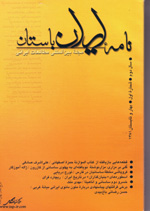|
-------------------------------------- Achaemenid pieces
fly out to London London officials are to showcase 300 pieces of Achaemenid era in a five-month show starting from 8, Sept, 2005 next to artworks from the celebrated La Louvre and British Museums. Most relics chosen from Achamanid works are comprising from stamps, coins and pots, the official said, but the contingent also includes two big stone culumns and humanoid animal - half human-half-animal creature - which is expected to amaze would-be visitors. The show is a response to those who plan to fade out rich Iranian history, the official said, alluding to the US film maker Robert Rossen's "Alexander the Great" movie where realities of the great Iranian Kings has totally been distorted. -------------------------------------- It is a high time to renew our knowledge about Khozestan!? Therefor……
The shocked and awed Shaykh dropped onto the boots of the young Major begging for a compromise. How about this diamond? This huge emerald? This chest of gold coins? How about these massive strands of the PERSIAN GULF pearls? In those days even that renegade Shaikh called it PERSIAN GULF! -------------------------------------- Iranian archaeologists have recovered remains of a human being during their latest search operations in Borj Tapeh archaeological site, in the northeast Neishabour provincial city, the head of the team Garajian told IRIB. A burnished piece of 24 carats turquoise has been fastend round the loin of the skeleton, he said. Researchers have began tests on the remains to determine the sex and the exact time to which it belonged. Relics pertaining to iron and Partian ages have already been discovered in the area. Stone tools, ovens as well as 12,000 pieces of potteries have been found in the site. --------------------------------------
-------------------------------------- Achaemenid Princess CHN The exhibition which collects its items from Iran's National Museum, the British Museum, and the Louvre, is to focus on the civilization, culture, and art of the Achaemenid era of Persia The casket and the princess possessions are kept in Louvre Museum since their discovery in Susa at the beginning of the 20th century. "At the beginning of the 20th century, diggings by Roland De Mecquenem, the French archaeologist, in the ancient city of Susa led to the discovery of a bronze unlidded casket including the skeleton of an Achaemenid princess, her jewelry and pottery buried alongside her. The discoveries were sent to Louvre right away," explained director of the Center for Achaemenid Studies, Shahrokh Razmju, adding that since today no trace of the skeleton is left, a moulage of the skeleton is to be recreated for the exhibition. At the time, a watercolor drawing of the casket was made from different angles which will be of help to experts to a make a moulage of the princess and recreate the casket exactly as it was the first day of its discovery. The exhibition of "Forgotten Empire: the World of Ancient Persia" will display some 400 historical objects from the Achaemenid period, 80 of which will be sent to London from Iran?s National Museum, and the rest will be from the collection of the British Museum itself and the Louvre.
|


